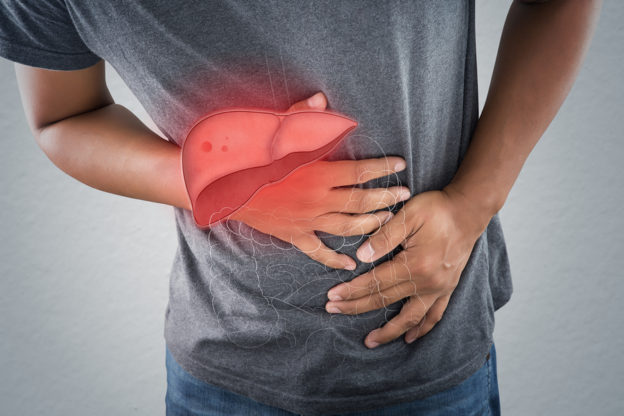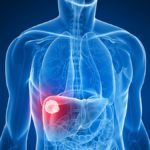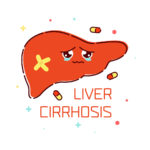By David Blyweiss, M.D., Advanced Natural Wellness
March 25, 2019
I’m very concerned about the health of your liver. And for good reason.
Today, there is a growing epidemic of a “silent” liver disease. At minimum, about one in three people here in the U.S. have it. But I’m convinced there are a lot more folks with this devastating liver disorder who have never received a diagnosis for it.
That’s because most people never even know they have it until serious health problems set in.
You can’t see it. You can’t feel it. There is no medication for it.
I’m talking about non alcoholic fatty liver disease (NAFLD).
In the past couple of decades I’ve seen a huge uptick in this silent killer in my own practice. And it’s no wonder!
Open your arteries, improve blood flow for a new health miracle...
Did you know your circulatory system has over 60,000 miles of arteries, veins and other blood vessels, if stretched end to end?
But as you age, your blood vessels undergo changes, which may cause them to stiffen, thicken and get clogged.
GOOD NEWS! Doctors have now identified a “Miracle Molecule” inside your arteries that helps OPEN your arteries and IMPROVE blood flow.
It’s what Dr. Valentin Fuster calls it, "One of the most important discoveries in the history of cardiovascular medicine."To you, that means...
- Healthy blood pressure
- Sharper mind and memory
- Skyrocketing energy and muscular strength
- Increased pleasure and passion in the bedroom
- Improved circulation to every cell and organ in your body
Go here to discover a new natural way to significantly boost the levels of this miracle molecule in YOUR body NOW!
Back in 2005 only about 15% of the U.S. population was estimated to have NAFLD. Today that estimate ranges from 30% to 40%. The prevalence has more than doubled… now affecting somewhere between 80 and 100 million Americans.
You can clearly see why I’m concerned, and you should be too. Especially since diagnostics used to identify the condition aren’t the most reliable.
For example, when your doctor sends in your blood work, levels of two liver markers are tested for. These include alanine aminotransferase (ALT) and aspartate aminotransferase (AST).
Now, as far as AST is concerned, it isn’t a very good indicator of liver damage. It’s found in all sorts of tissue – from your muscles to your heart to your kidneys. So a simple muscle injury can raise levels.
ALT, on the other hand, is much more concentrated in the liver. And when you experience liver injury or damage, it gets released into your bloodstream. This makes it an excellent marker of your liver status.
The problem is, “normal” AST values are generally set way too high.
In most laboratories, the cut-off range for “normal upper limits” is around 40 IU/L. This is MUCH too high to be considered ANY kind of normal, even upper range. (It’s long been proven that levels greater than 30 exponentially increase your risk of dying from liver disease.)
More reasonable cut-off levels are an ALT upper limit of 29 IU/L for men and 22 IU/L for women.
The World's Quickest Solution for Ending Prostate and Urinary Misery
This has recently been revealed to be one of the only real breakthroughs in prostate health.
The seeds of a strange fruit (sometimes called "Chinese Apples") hold powerful phytonutrients that are a revolution in prostate health.
In fact, UCLA and Veterans Administration research have now proved this to be true.
Not only that, but it may be the worlds quickest solution for ending prostate misery.
Simply stated, these phytonutrients represent a huge step beyond beta sitosterol, saw palmetto, and other phytosterols alone.
Simply click HERE if you want to have fast prostate relief...restful, uninterrupted sleep...no more constant "urges to go"...enhanced virility...and optimal prostate support for life.
So when I see male patients who fall in the 29-33 IU/L category and women who fall between 22-25 IU/L, I get serious real fast. When these levels are reached I know one thing for sure: In these ranges my patients’ health and longevity is going to spiral downhill very quickly.
(Keep in mind that NAFLD is now the second most common reason for liver transplant and a top cause of liver cancer here in the U.S. Neither of these are a situation you ever want to be in!)
I hope you are as serious as I am, because there is only one thing to do under these circumstances:
Save Your Liver to Save Your Life!
Lose weight. Easier said than done, I know. But just a 5% weight loss can reduce the fat content in your liver by about a third. And if you lose up to 10% of your body weight you can even slash levels of inflammation that may be damaging your liver.
I have two great weight-loss articles in the Advanced Natural Wellness archive. One of them zeroes in on filling your diet with delicious, nutrient rich foods that quickly melt pounds away. The other discusses how the timing and content of your meals can have a huge impact on your weight-loss efforts.
If you’re overweight, I recommend taking the helpful advice in these articles to heart.
Keep moving… (Or if you are sedentary get moving!) A long, brisk walk every day might be just what you need to lower those elevated ALT liver enzymes. And if you’re up to it, try more challenging exercises like squats, jumping jacks and push-ups. Start off at a comfortable level, then give it your all for 30 seconds or so. Rest a minute or two and then repeat a few more times. Just check with your doctor before getting too vigorous.
Slash the sugar. Even the most healthful of us enjoy sugary foods every now and then. But you have to set a limit. Here’s a perfect example. When a group of healthy men with low liver fat started eating 650 calories from sugar each day for 12 weeks, their fat metabolism changed and increased their storage of liver fat. So forego the soda, ice cream, sweet tea and other sweets whenever possible. (Water, unsweetened tea, plain Greek yogurt and naturally sweet fruits are all great alternatives.)
I also recommend supporting your liver with four liver-supporting supplements:
- 420–600 mg of silymarin daily. This is an herbal extract of milk thistle that has a direct effect on inflammation and scarring in liver cells. Make sure it is standardized to 80 percent silymarin content.
- 500 mg of resveratrol for 12 weeks to reduce levels of damaging liver enzymes, cut down on inflammation and help release fat from liver cells
- 250-750 mg of CDP choline (citicoline) daily. Start at the low end and work your way up to 750 mg each day in divided doses.
- 2,000 to 8,000 IU of vitamin D3 in the cholecalciferol form. (2,000 to maintain. 5,000 if your levels are slightly low. 8,000 for deficiency.) People with low levels of vitamin D are about 26% more likely to develop fatty liver than those with adequate levels. Have your doc retest every three months and adjust levels accordingly.
SOURCES:
Perumpail BJ, et al. Clinical epidemiology and disease burden of nonalcoholic fatty liver disease. World J Gastroenterol. 2017 Dec 21;23(47):8263-8276.
Kim HC, et al. Normal serum aminotransferase concentration and risk of mortality from liver diseases: prospective cohort study. BMJ. 2004 Apr 24;328(7446):983.
Ruhl CE, et al. Upper limits of normal for alanine aminotransferase activity in the United States population. Hepatology 2012; 55:447–454.
Kwo PY, et al. ACG Clinical Guideline: Evaluation of Abnormal Liver Chemistries. Am J Gastroenterol. 2017 Jan;112(1):18-35.
Novel concepts for the diagnosis of fatty liver and personalized treatment. Press Release. DEUTSCHES ZENTRUM FUER DIABETESFORSCHUNG DZD via EurekAlert. Aug 2018.
The skinny on fatty liver disease. Harvard Men’s Health Watch. Harvard Medical School. Jan 2018.
Xiao J, et al. Recent Advances in the Herbal Treatment of Non-Alcoholic Fatty Liver Disease. J Tradit Complement Med. 2013 Apr-Jun; 3(2): 88–94.
Faghihzadeh F, et al. Resveratrol supplementation improves inflammatory biomarkers in patients with nonalcoholic fatty liver disease. Nutr Res. 2014 Oct;34(10):837-43.
Corbin KD, et al. Choline metabolism provides novel insights into nonalcoholic fatty liver disease and its progression. Curr Opin Gastroenterol. 2012 Mar;28(2):159-65.
Sherriff JL, et al. Choline, Its Potential Role in Nonalcoholic Fatty Liver Disease, and the Case for Human and Bacterial Genes. Adv Nutr. 2016 Jan; 7(1): 5–13.
Eliades M, et al. Vitamin D: A new player in non-alcoholic fatty liver disease? World J Gastroenterol. 2015 Feb 14; 21(6): 1718–1727.







